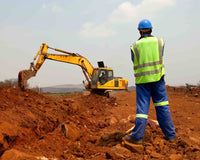Today we’re going to take a look not at a particular product or line of products, but at a trend in the labor world that’s worth noting. According to official OSHA estimates, 5 million workers are required to wear respiratory protection in 1.3 million workplaces across the country. As further innovation occurs and industry expands further, these figures will only increase. It is more imperative now than ever that employers cooperate with OSHA to test their work areas, and then comply with regulations with respiratory safety programs.
The respiratory protection field is changing, with new products and new features being introduced every day. Often, the focus in promotional material is on the improved ergonomics of these products. This makes sense, as a more comfortable respirator is always going to sell better than the older models (assuming that it’s being promoted effectively as such and customer response is positive). Far from being merely an aesthetic improvement, ergonomic innovation has a direct positive relationship with increased productivity. A more physically comfortable worker will work faster and more consistently, without the distraction of an uncomfortable facepiece. These improvements have naturally led to a higher degree of compliance and an enthusiastic embrace of respiratory technology, simply because it’s so much easier to wear for extended periods of labor. These innovations have brought a whole new level of effectiveness and convenience to difficult tasks. The firefighting community, in particular, has seen drastic improvements to its old equipment, bringing that profession into a new age. Lighter masks, wider fields of vision, integrated communication and thermal imaging technology, and much more are becoming increasingly common.
You may also like to read: Features of 3M Aura Respirator 9210+
Every respiratory program in the country needs official medical clearance and formalized fit testing procedures for each product being used. Respirators are only worthwhile if they are being worn and maintained properly; otherwise they may as well not exist. There are precise procedures and literature available from OSHA that outline in detail everything an employer must do to ensure his workers’ safety. Also of paramount importance is the selection of products appropriate to the hazards at hand. If a worker goes into an area contaminated with a particular chemical, wearing a respirator that’s designed to filter out a different chemical, then the whole thing is a potentially deadly farce. Precision, accuracy, and diligence are essential to a protection program in any category, but particularly when it comes to respiratory health.
The stakes couldn’t be higher. Employee health should always be a top priority at any honest company, but respiratory health is particularly vital and can seem particularly arcane because of the extremely gradual onset of the damage and the fact that it’s all interior (you can’t easily see and assess a damaged lung the way you can, say, a broken leg). OSHA has to be involved in as many steps as possible of the development and implementation process, to guarantee that everything is set up according to their guidelines and standard operational procedures. 5 million lives are on the line here. We can’t afford to risk even one more than absolutely necessary.





